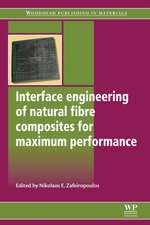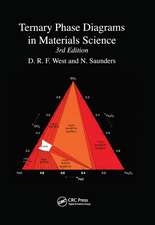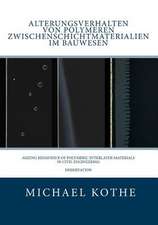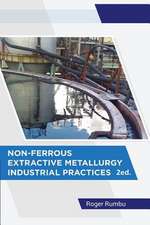Microbiological Corrosion of Buildings: A Guide to Detection, Health Hazards, and Mitigation: Occupational Safety, Health, and Ergonomics
Editat de Rafał Górnyen Limba Engleză Paperback – 31 mai 2023
Features:
- Latest methods for detection of indoor microbial hazards
- Identifies the tools needed for natural, non-destructive and non-invasive methods of bio-corrosion removal
- Describes the social and health problems associated with exposure to microbiological hazards
- Provides case studies and examples of microorganisms responsible for microbial corrosion.
—Prof. Jacek Dutkiewicz, Ph.D., D.Sc., Institute of Rural Health in Lublin
| Toate formatele și edițiile | Preț | Express |
|---|---|---|
| Paperback (1) | 312.43 lei 6-8 săpt. | |
| CRC Press – 31 mai 2023 | 312.43 lei 6-8 săpt. | |
| Hardback (1) | 889.96 lei 6-8 săpt. | |
| CRC Press – 10 aug 2020 | 889.96 lei 6-8 săpt. |
Preț: 312.43 lei
Preț vechi: 356.64 lei
-12% Nou
Puncte Express: 469
Preț estimativ în valută:
59.79€ • 64.92$ • 50.22£
59.79€ • 64.92$ • 50.22£
Carte tipărită la comandă
Livrare economică 23 aprilie-07 mai
Preluare comenzi: 021 569.72.76
Specificații
ISBN-13: 9780367499891
ISBN-10: 0367499894
Pagini: 164
Ilustrații: 6 Tables, black and white; 10 Line drawings, black and white; 14 Halftones, black and white; 24 Illustrations, black and white
Dimensiuni: 156 x 234 mm
Greutate: 0.45 kg
Ediția:1
Editura: CRC Press
Colecția CRC Press
Seria Occupational Safety, Health, and Ergonomics
ISBN-10: 0367499894
Pagini: 164
Ilustrații: 6 Tables, black and white; 10 Line drawings, black and white; 14 Halftones, black and white; 24 Illustrations, black and white
Dimensiuni: 156 x 234 mm
Greutate: 0.45 kg
Ediția:1
Editura: CRC Press
Colecția CRC Press
Seria Occupational Safety, Health, and Ergonomics
Public țintă
Academic and Professional Practice & DevelopmentCuprins
1. Introduction. 2. Water damage in buildings and associated microbiological contamination. 3. Main factors of microbiological contamination of indoor environments. 4. Epidemiology of microbiological contamination of indoor environments. 5. Environmental conditions for microbiological contamination of buildings. 6. Biodeterioration of building materials. 7. Methods of identifying indoor microbial hazards. 8. Assessment of the level of microbiological contamination of air and surfaces. 9. Methods of drying buildings. 10. Combating microbial corrosion in buildings. 11. Indoor microbiological contamination from a legal perspective. 12. Microbial corrosion of buildings in everyday practice.
Notă biografică
Rafał L. Górny, PhD, a full professor of medical sciences, is currently head of the Laboratory of Biohazards at the Central Institute for Labour Protection – National Research Institute, Warsaw, Poland. In the last 25 years of professional work, he has been engaged in numerous studies on the health-related aspects of exposure to particulate, biological, and fibrous aerosols in occupational and non-occupational environments. His research efforts have been presented in more than 70 peer-reviewed publications, more than 100 conference presentations, several monographs and book chapters. Since 2002, he has been working as a World Health Organization and European Commission adviser within the field of biological agents.
Recenzii
"Climate change and the associated adverse effects, such as floods and whirlwinds, make the problem of microbiological corrosion of buildings that generates health risks and economic losses on a global scale, the focus of science and technology. The monograph presents a complex problem of building bio-corrosion, that requires the knowledge of distant fields of microbiology and building technology, for the use of both, scientists and practitioners. This pioneering work of interdisciplinary nature harmoniously combines the knowledge on specific microbiological issues relating to the process of bio-corrosion and the associated health risks with detailed issues of construction technology concerning the prevention of bio-corrosion and its removal. The authors succeeded in combining a very high scientific level of the monograph with an accessible and understandable presentation of complex problems. The extensive references, ranging from ‘classical’ items from many years ago to the most recent articles presenting the state-of-the-art in this field, are worth emphasizing."
—Prof. Jacek Dutkiewicz, PhD, DSc, Institute of Rural Health in Lublin
—Prof. Jacek Dutkiewicz, PhD, DSc, Institute of Rural Health in Lublin
Descriere
Environmental stress caused by water, expose structures to microbial colonization. This is evident when both minor dampness and mass flooding occur. It describes how biological corrosion of buildings and structures resulting from these hazards are responsible for the adverse health effects on people exposed to these contaminated environments.


































